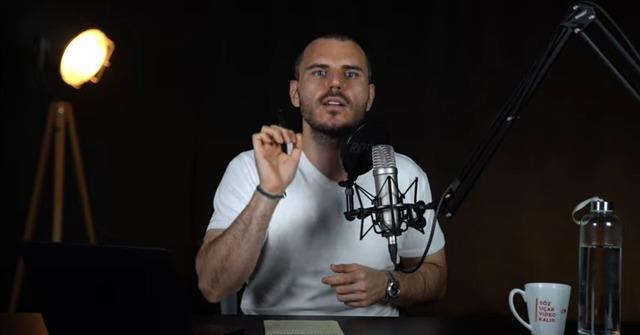on YouTube “Human Conditions” Alican Elkorek, who made a name for himself with his broadcasts on his channel, shared important information about the brain and nervous system. prepared by “How does our brain work?” Elkorek includes valuable and up-to-date scientific information about memory, emotions, thoughts, actions, sleep and much more in his video titled: “Have you ever thought about how our brain and body work?” He looked for an answer to his question.
Relationship between brain and nervous system ‘magic dance’ In the video in question, Elkorek drew attention to the change in the functions of the central nervous system and brain.
Elkorek shared the following information;
“Today, we will take an in-depth look at the mysterious world of our brain and nervous system. Our brain is not only an organ in our head, but also an orchestra that works in an integrated manner with a tremendous interaction between our Central Nervous System, Spinal Marrow and Eyes.
From the moment we are born, every emotion, thought and action we feel takes place in this eye-brain-spinal line, that is, in our central nervous system. This means that it is impossible to separate our brain and body.
Our emotions and thoughts are part of a dance that ebbs and flows; We call this “states”. When we fall in love, get angry or excited, different chemical reactions occur in our body.
Our nervous system forms the basis of our biological existence. Everything we feel, every moment we experience, is shaped in this complex system. You can follow the Human Conditions episodes on Youtube and Instagram to discover how we can turn this process into an advantage in our daily lives.
Now, let’s first try to understand in a little more detail what is going on in our brain and body.
WHAT ARE THE FUNCTIONS OF OUR CENTRAL NERVOUS SYSTEM AND OUR BRAIN?
1. Sensing / Feeling: As humans, we perceive the world through our five senses. Our body and brain continue to sense constantly, without questioning or stopping. We can perceive these sensations and decide how we interact with them. Like other living things, we interact with our environment using our own unique senses. For example: If something pricked your foot right now, you would feel it. If something comes your way, you will see it. Sensing is passive.
2.Perception/Comprehension: Perceiving means understanding the situation we sense and acting accordingly. Our ability to direct the spotlight on our mental stage in the direction we want shapes our perception. This allows us to consciously evaluate and understand our environment. For example: If I ask you to feel your right foot, you can do this.
3.Emotions: One of the important functions of our nervous system is to regulate emotions. Neurologists, psychologists, and philosophers have debated the meaning of emotions and how they work for years. But apparently this process happens in our nervous system through various chemicals and electrical cycles. Although these emotions are generally perceived as feelings that are beyond our control and that happen to us, it is actually possible to transform and regulate them.

4.Thinking: Discovering our thought pathways, directing them and shaping them the way we want, choosing positive thought chains is a process that strengthens the communication between our brain and body. By choosing our thoughts from our past experiences or future projections, we can both learn lessons and make plans for the future.
5.Taking Action: The sensations, perceptions, emotions and thoughts we carry out throughout life eventually turn into visible actions. Our actions such as writing, sharing, creating, designing, working and producing form the basis of the traces we leave in this world.
Our brain and central nervous system are parts of a complex dance that constantly interacts with each other. Understanding and using this system can make our daily lives more conscious, more controlled and more meaningful.
Now, let’s dig a little deeper and look at one of our favorite topics:
Let’s focus on “neuroplasticity”.
NEUROPLASTICITY: THE CHANGING FACE OF THE BRAIN
Would you like to learn the formula for change?
When we want to change ourselves, acquire a new skill or gain permanent motivation for a language, instrument, sport, habits or anything that involves deep learning processes, neuroplasticity is the key to achieving these goals. It is quite easy to allow our brain to form new neurons related to a specific topic, especially during childhood and adolescence. However, this process is still quite possible, although it may require a little more effort as you get older.

At this point, epinephrine release, i.e. concentration, is a key factor to increase our neuroplastic development. As we focus, our neuronal connections become stronger. As we increase our ability to focus, permanent changes occur in our brain and nervous system. The longer our intensity and duration, the more effective our process of achieving neuroplasticity. Excitement and tension are among the stimuli that contribute to this process by increasing learning and focus.
An important detail that should not be forgotten is that the formation of these new neurons and the communication between the strengthened connections occur during sleep, not during the act of learning. Sleep is a key factor of good learning and neuroplasticity.
Here, in this brief summary, we tried to understand the complexity of the brain and nervous system. We manage our brain and body orchestra with the orchestra conductor of our nervous system. Our eyes are a part of this magnificent orchestra and brain. This structure is a sophisticated nervous system designed by nature that maintains the energy and communication cycle that connects our inner world with our outer world by using the abilities of sensing, perceiving, feeling emotions, thinking and acting. First of all, it is useful to take a moment and be thankful that we are a part of this process.
Mastering our autonomic nervous system is one of the biggest trends today. Understanding and regulating this system is a critical ability to explore and control our inner world. As we change, our environment also changes; As we learn, our environment also learns; As our environment learns, the world changes.
This comprehensive perspective aims to help us understand the interaction of our brain and nervous system. “In future articles, we will continue to deepen this knowledge and explore how we can apply it to our daily lives.”
‘HOW DOES THE BRAIN WORK?’ ON YOUTUBE CLICK TO WATCH THE VIDEO

